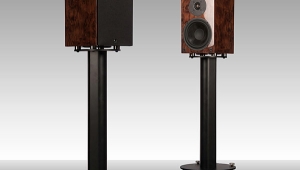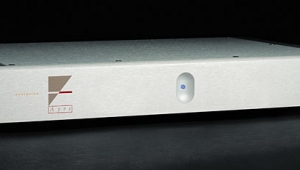| Columns Retired Columns & Blogs |
The Fifth Element #6 Page 2
Case C is the Wunnerful Wunnerful Power Cord Company. Wunnerful consists of a P.O. box, some electrons on the Internet, and some braided sheath and heat-shrink tubing custom-imprinted with Wunnerful's logo. Total investment: less than $500. Wunnerful's marketing program was to hand out a dozen power cords to e-zine reviewers, winking and nudging that Wunnerful didn't need them back any time soon. Said reviewers dutifully created an Internet buzz, and (best Claude Rains voice) I am shocked, shocked to find that one or two reviewers sold the review samples at half off retail price, then kept the proceeds! Incroyable.
Footnote 3: Or even digital. I'm not privy to the events that led to Audio Alchemy's demise, but I don't think it unreasonable to suppose that inadequate cost data and controls, exacerbated by overly aggressive discount pricing, were major factors.
When Wunnerful gets e-mail orders, Wunnerful's CEO makes a trip to his local Home Depot to buy the requisite terminations and generic bulk cable, such as is used to wire up electric clothes dryers. A few minutes' work assembles the cable while disguising its true origins, and another Wunnerful Wunnerful Amber Nematode Power Cord is on its way to its bedazzled new owner, whose charge-card balance is now weightier by $295 plus shipping.
Case D is the Artisan Loudspeaker Company. Artisan, like Applied Coatings, pays rent on sizable premises, pays all the usual overhead items, but has six employees rather than 20. In place of vans and a cherry picker, Artisan has to lay out for a ship-container-load of speaker cabinets at a time, in advance, the cabinets being made in Denmark and featuring book-matched veneers.
Artisan pays to exhibit at three trade shows a year and for color advertising in the magazines, and provides its dealers with color catalogs. The dealers have to cover the costs of holding inventory and keeping their showrooms open, but at the end of the day the dealer makes as much on each sale as does Artisan. Had Artisan's founder taken the same amount of money he used to start his company 20 years ago and put it instead into a Dow index fund, then gone to work for someone else, today he'd be worrying about capital-gains taxes instead of about meeting payroll.
Two housepainting companies, two audio companies. The moral of these stories is that I think every "mission statement" should open with something along these lines: "The first responsibility of XYZ Company is to operate in a consistently profitable manner, both from a conviction that what we are doing is of sufficient value to ourselves and our community that we should be able to continue doing it indefinitely, and in recognition of our financial responsibilities to our employees, vendors, and society."
Professional painting contractors often have to take the time to explain that applying good paint properly requires skills and infrastructure that cost substantial money, which is why they can't meet Sammy's bid halfway and remain in business. Similarly, in all fairness, I think high-end audio hardware consumers must give more thought to what it takes to run an audio company that can be in a position—over the long haul—to fulfill its obligations to its employees, vendors, and customers. (I am aware that you can buy a new Daewoo automobile for the same price as a pair of Wilson Benesch Discoverys. I am also aware that Daewoo is in bankruptcy, with $80 billion in debt.)
Too many audio manufacturers—especially of products for which the barriers to entry are low, such as loudspeakers (footnote 3)—have sought to buy market share by setting prices unrealistically low. Not having a handle on costs, the more business they get, the deeper they dig themselves in. Either the prices have to go up, which makes people think "bait and switch," or the company folds, usually leaving very unhappy vendors, customers, and investors.
I am not proposing a new rule requiring that nobody can get near the water until they know how to swim; I am reminding everyone, though, that if a deal looks too good to be true, it probably is.
But as the cable market shows, higher prices alone do not guarantee value, let alone quality. Neither does simple corporate longevity. Some very-well-managed companies have churned out uninspiring mid-fi for years, and apparently will continue to do so indefinitely.
Admittedly, also, there have been a few shrewd audio entrepreneurs whose business plan has been: 1) create legend about oneself; 2) hire others to design some very good products, then charge two to three times what anyone else would dare to; and 3) let the aura trickle down to ordinary products with high prices. But while there have been only a few of those chaps, there have been dozens if not hundreds of boom-and-bust audio companies.
There is also an ethical dimension to choosing how one spends one's money. Over and above anything else: Are the workers getting a decent wage, is the workplace safe and healthy, and is the natural environment being respected?
Back to the Wilson Benesch Discovery. I believe—without reservation—that this speaker embodies sufficiently radical departures in design, materials, and execution that its somewhat eye-popping price passes muster under the foregoing test of costing compared to reasonable norms.
The other cost-justification test is much simpler to explain: Does the component sound as if it's worth the money? In other words, is there another way to spend a like amount that will result in better sound?
That test is actually harder to apply, because it turns on one's judgment of what sounds better. The same amount of money should be spent differently if the goal is to reproduce every possible nuance of Baroque trio-sonata recordings in a book-lined study, as opposed to playing Madonna's "Ray of Light" at dance-club volume levels in a large room.
Footnote 3: Or even digital. I'm not privy to the events that led to Audio Alchemy's demise, but I don't think it unreasonable to suppose that inadequate cost data and controls, exacerbated by overly aggressive discount pricing, were major factors.
- Log in or register to post comments




































